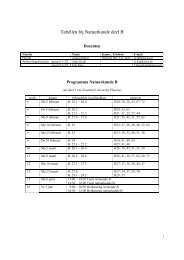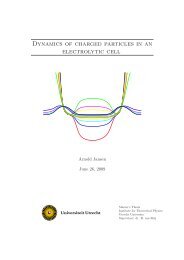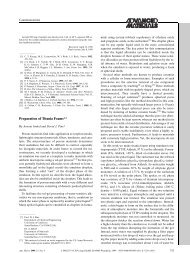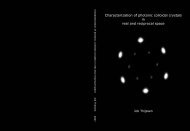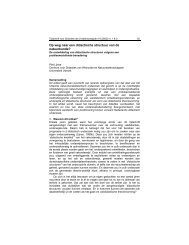Sedimentation Equilibrium of Mixtures of Charged Colloids
Sedimentation Equilibrium of Mixtures of Charged Colloids
Sedimentation Equilibrium of Mixtures of Charged Colloids
You also want an ePaper? Increase the reach of your titles
YUMPU automatically turns print PDFs into web optimized ePapers that Google loves.
Monte Carlo simulations <strong>of</strong> figure 3 <strong>of</strong> Ref.[15]: σ = 150nm, H = 1000σ,λ B = σ/128, L 1 = 3L 2 2 = 10σ, ¯η 1 = ¯η 2 = (π/6) × 10 −4 , Z 1 = 15, and Z 2varies between 15 and 45. The simulated system does not contain addedsalt but only counterions, which we can represent within our theory by theextremely low reservoir salt concentration ρ s = 1nM, which we checked tobe low enough to be in the zero-added-salt limit as regards the colloidalpr<strong>of</strong>iles. In Fig.1(a) we show, for Z 2 = 45, the density pr<strong>of</strong>iles <strong>of</strong> the twocolloidal species, as well as that <strong>of</strong> the counterions (and the coions) in theinset. We observe pr<strong>of</strong>ound colloidal segregation into two layers, with theheavy species floating on top <strong>of</strong> the lighter ones. The counterions are seen tobe distributed throughout the whole volume, i.e. much more homogeneouslythan when all colloids would have been barometrically distributed in a thinlayer <strong>of</strong> thickness L i just above the bottom (since in that case the net ioncharge would have been located in that same thin layer). The resulting gain<strong>of</strong> ion entropy is the driving force for the formation <strong>of</strong> the electric field thatpushes the heavy (highly charged) colloids to high altitudes against gravity[8, 14]. In Fig.1(b) we show the mean height h i <strong>of</strong> species i, defined ash i =∫ H0 dx x ρ i(x)∫ H0 dx ρ i(x) , (A.5)as a function <strong>of</strong> Z 2 . We replot the Monte Carlo simulation results <strong>of</strong> figure3 <strong>of</strong> Ref.[15] (symbols), together with the predictions for h i that follow fromthe present theory (continuous curves). Given that there is not a single fitparameter involved, the agreement is remarkable, certainly when comparedwith the theoretical analysis on the basis exponentially decaying density pr<strong>of</strong>ilesas in Ref.[15]. Fig.1 shows that the heavy particles are on top <strong>of</strong> thelighter ones, h 2 > h 1 , provided Z 2 /Z 1 ≃ 1.6. For barometric pr<strong>of</strong>iles onewould find that h i = L i , but we see in all cases that h i ≫ L i due to the lifteffect <strong>of</strong> the induced electric field. The good agreement between theory andsimulation in Fig.1(b) also indicates that hard-core effects (which are takeninto account in the simulations but not in the theory) are not so relevant, atleast not in the parameter regime studied here.The next system we study is a ternary system (n = 3) in a solvent characterisedby λ B = 2.3nm (ethanol at room temperature) with a reservoirsalt concentration ρ s = 10µM and meniscus height H = 20cm. The colloidalcharges and gravitational lengths are Z i = (1000, 250, 125) and L i =(1, 2, 1)mm, respectively, and the system is equimolar with ¯η i = 0.005 for allthree species. Fig. 2 shows the density pr<strong>of</strong>iles as predicted by the presenttheory in (a), as well as the electric field in (b). We find almost perfect segregationinto three layers, such that the mean heights satisfy h 3 < h 2 < h 1 .57




